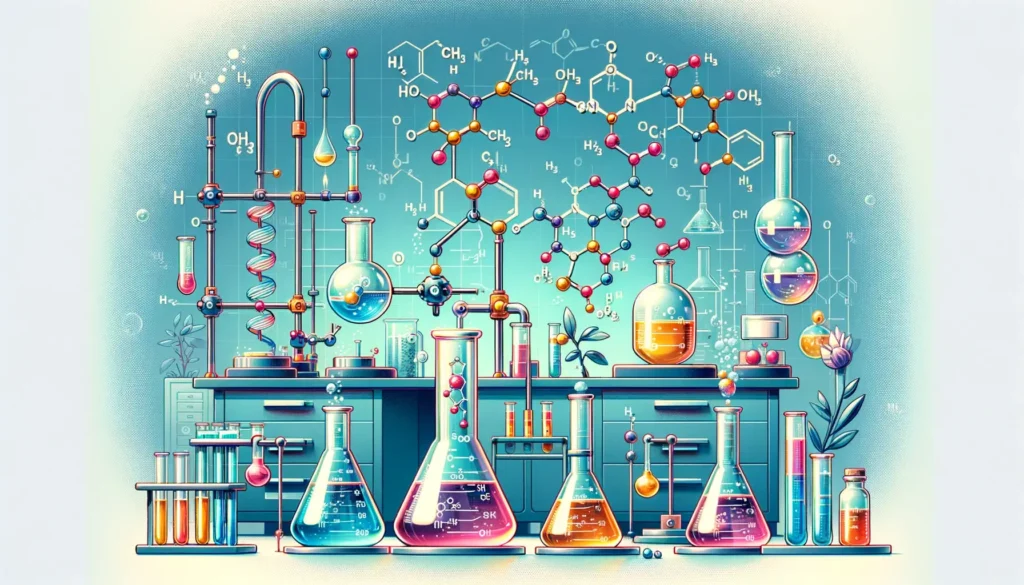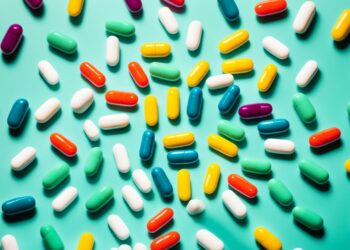Did you know that hormonal imbalances in men can have far-reaching effects on their overall health and well-being?
Testosterone and estrogen levels play a crucial role in various physiological processes, from bone density to the regulation of reproductive function. However, an unexpected fact highlights a key aspect of men’s health: the impact of aromatase inhibitors.
Studies have revealed a surprising statistic, showcasing the potential of aromatase inhibitors in men’s health. These inhibitors have been found to effectively delay epiphyseal maturation in boys and improve testosterone levels in adult men.
They may even be used to increase adult height in boys with certain puberty-related conditions. Furthermore, aromatase inhibitors have shown promise in the treatment of pubertal disorders, the andropause, and gynecomastia.
Key Takeaways:
- Aromatase inhibitors offer potential benefits in hormone regulation and men’s health.
- Studies have demonstrated their effectiveness in delaying epiphyseal maturation and improving testosterone levels in men.
- These inhibitors may be used to increase adult height in boys with certain puberty-related conditions.
- Aromatase inhibitors show promise in the treatment of pubertal disorders, the andropause, and gynecomastia.
- Further research is needed to establish the long-term efficacy and safety of aromatase inhibitor therapy in males.
The Role of Aromatase in Men’s Health
Aromatase is an essential enzyme in the male body that converts androgens to estrogens. Among these estrogens, estradiol, in particular, plays a vital role in several crucial processes, including bone mass maintenance, epiphyseal closure, and regulation of gonadotropin secretion.
Aromatase dysregulation can lead to imbalances in estrogen levels, which can have significant impacts on men’s health. Deficiencies or excesses of estrogen can give rise to various health problems, affecting both physical and hormonal well-being.
The good news is that medical science has developed a class of drugs known as aromatase inhibitors, which are designed to inhibit the activity of the aromatase enzyme. By doing so, these inhibitors effectively reduce estrogen synthesis in the body, maintaining a more favorable balance of hormones.
“Aromatase inhibitors act by inhibiting the activity of the aromatase enzyme, thus reducing estrogen levels.”
Aromatase inhibitors have shown promising results in controlling estrogen synthesis and balancing hormone levels in men. By inhibiting the aromatase enzyme, these inhibitors help regulate estrogen levels, which can have far-reaching effects on overall health and well-being.
Reducing estrogen levels through the use of aromatase inhibitors can be particularly beneficial in conditions where estrogen dysregulation is observed. This includes conditions such as gynecomastia, a condition characterized by the enlargement of breast tissue in males.
It’s important to note that aromatase inhibitors should only be used under medical supervision as they can impact other hormone levels, such as testosterone.
A healthcare professional will assess the patient’s individual circumstances and determine the appropriate use and dosage of aromatase inhibitors for optimal health outcomes.
Metabolism of Estrogens in Men
Estradiol, the most potent estrogen in the male body, is synthesized through the action of aromatase, converting testosterone or estrone. The synthesis of estradiol plays a crucial role in maintaining hormonal homeostasis in men.
The estimated daily production rate of estradiol in men is around 35-45 μg, with the testes accounting for approximately 60% of this synthesis. The remaining estradiol is derived from the peripheral conversion of adrenal androgens.
The balance between testosterone and estradiol levels is essential for optimal health and wellbeing in males. Testosterone conversion to estradiol enables the body to regulate various processes, including bone metabolism, sexual function, and the overall endocrine function.
However, dysregulation of this synthesis pathway can lead to hormonal imbalances and related health issues.
Understanding the synthesis and metabolism of estrogens in men is crucial for assessing and managing hormonal health.
The peripheral production of estradiol, in addition to the testicular synthesis, highlights the importance of considering the entire pathway of estrogen synthesis when evaluating hormonal imbalances in males.
Optimizing the balance between testosterone and estradiol levels can support overall hormone regulation and contribute to improved health outcomes.

Phenotypes of Aromatase Deficiency and Excess
Aromatase deficiency and excess are two distinct conditions that can have significant impacts on male health. Understanding these phenotypes is essential for recognizing the importance of estrogen in the male body and exploring the potential uses of aromatase inhibitors.
Aromatase Deficiency
Aromatase deficiency is a rare condition characterized by low estrogen levels and impaired aromatase activity. This condition can manifest in various ways:
- Low bone mineral density: Without adequate estrogen levels, bone health can be compromised, leading to reduced bone density and an increased risk of fractures.
- Unfused epiphyses: Aromatase plays a critical role in the closure of epiphyseal plates, which are responsible for bone growth. Aromatase deficiency can result in delayed epiphyseal fusion.
- High gonadotropin and testosterone levels: In response to low estrogen levels, the body compensates by increasing gonadotropin (follicle-stimulating hormone and luteinizing hormone) and testosterone production.
Aromatase Excess Syndrome
Aromatase excess syndrome, on the other hand, is characterized by excessive estrogen synthesis due to overactive aromatase enzyme activity. This condition can lead to the following phenotypes:
- Gynecomastia: Aromatase excess can cause the development of breast tissue in males, resulting in enlarged breasts.
- Accelerated growth: Excessive estrogen levels can cause accelerated linear growth and early puberty.
- Premature bone maturation: Aromatase excess can lead to the premature closure of epiphyseal plates, resulting in stunted growth and skeletal abnormalities.
These phenotypes highlight the critical role of estrogen in male health and hormone regulation. They provide valuable insights into the potential uses of aromatase inhibitors in managing these conditions and maintaining hormonal balance in men.
Aromatase Inhibitors and Their Classification
Aromatase inhibitors are categorized as either steroidal or nonsteroidal, and they can also be classified into different generations.
Steroidal inhibitors mimic androstenedione, the substrate of aromatase, to inhibit its activity. On the other hand, nonsteroidal inhibitors bind to the heme iron of the enzyme, preventing estrogen synthesis.
The classification of aromatase inhibitors is based on their strength and specificity. First-generation inhibitors are relatively weak and nonspecific, while third-generation inhibitors like letrozole and anastrozole are potent and specific in their action against aromatase.
Table: Classification of Aromatase Inhibitors
| Type | Examples |
|---|---|
| Steroidal Inhibitors | Exemestane |
| Nonsteroidal Inhibitors | Letrozole, Anastrozole |
| First-Generation Inhibitors | Aminoglutethimide, Testolactone |
| Third-Generation Inhibitors | Letrozole, Anastrozole |
These inhibitors have been extensively studied and proven effective in reducing estrogen levels in women. However, their potential benefits in men are also being explored, particularly in the management of conditions related to estrogen dysregulation.
Effects of Aromatase Inhibition on Hormone Levels
Aromatase inhibitors have shown significant effects on hormone levels in men, specifically in terms of luteinizing hormone (LH) release and testosterone production. By inhibiting the activity of the aromatase enzyme, these inhibitors lower estrogen levels in the body, resulting in various hormonal changes.
The decrease in estrogen levels caused by aromatase inhibition can modulate the feedback loop of gonadotropin secretion, leading to an increase in luteinizing hormone release. Luteinizing hormone is essential for stimulating the production of testosterone in the testes.
Aromatase inhibitors have been widely used in the treatment of men with low testosterone levels.
However, it’s important to note that the response to aromatase inhibition may vary depending on the individual’s baseline hormone levels and the specific type of testosterone therapy being used. Different individuals may have different levels of sensitivity to aromatase inhibitors, which can affect the overall impact on hormone levels.
A thorough evaluation of an individual’s hormonal profile is crucial when considering the use of aromatase inhibitors in testosterone therapy.

| Hormone | Normal Range | Effect of Aromatase Inhibition |
|---|---|---|
| Luteinizing Hormone (LH) | 5-10 mIU/mL | Increased release |
| Testosterone | 300-1000 ng/dL | Increased production |
| Estrogen | 10-40 pg/mL | Decreased levels |
These hormone level changes induced by aromatase inhibitors can have significant implications for men’s overall health and well-being. By modulating the balance between estrogen and testosterone, aromatase inhibitors play a crucial role in regulating hormonal homeostasis in men.
“Aromatase inhibitors have shown remarkable effects on luteinizing hormone release and testosterone production in men, making them a valuable tool in testosterone therapy.”
While further research is needed to fully understand the long-term effects and safety of aromatase inhibitors in men, the existing evidence suggests their potential benefits in hormone regulation and therapeutic interventions.
The Utilization and Impact of Aromatase Inhibitor Therapy
A study conducted on men with elevated estradiol levels on testosterone therapy (TTH) found that the use of anastrozole, an aromatase inhibitor, resulted in a significant reduction in estradiol levels while maintaining appropriate testosterone levels.
The study did not identify any specific predictive factors for men who were more likely to respond to aromatase inhibitor therapy. However, it demonstrated that aromatase inhibitors can be an effective option for reducing estradiol levels in men on TTH.
Conclusion
Aromatase inhibitors are essential in regulating estrogen levels in men and have demonstrated potential benefits for men’s health, including hormone regulation and the treatment of specific disorders.
Current evidence suggests that these inhibitors can effectively manage elevated estrogen levels and maintain hormonal balance in men. However, further research is necessary to establish the long-term efficacy and safety of aromatase inhibitor therapy in men.
By inhibiting the action of the aromatase enzyme, aromatase inhibitors reduce the conversion of androgens to estrogens, thus regulating estrogen synthesis in the male body. This allows for greater control over hormonal imbalances and associated health problems that arise due to estrogen dysregulation.
While aromatase inhibitor therapy holds promise, it is essential to consult with healthcare professionals who specialize in men’s health and hormone therapy to determine the most appropriate treatment plan.
They can provide guidance regarding the use of aromatase inhibitors and monitor the patient’s response to ensure optimal outcomes and minimize any potential risks.
FAQ
What are the key benefits of aromatase inhibitors for men?
Aromatase inhibitors have been found to effectively delay epiphyseal maturation in boys and improve testosterone levels in adult men. They may be used to increase adult height in boys with certain puberty-related conditions.
Additionally, aromatase inhibitors have shown potential benefits in treating pubertal disorders, the andropause, and gynecomastia. However, the long-term efficacy and safety of these inhibitors in males have not been fully established.
What is the role of aromatase in men’s health?
Aromatase is the key enzyme responsible for converting androgens to estrogens in the body. In men, estradiol, a type of estrogen, plays a crucial role in processes like bone mass maintenance, epiphyseal closure, and regulation of gonadotropin secretion.
Deficiencies or excesses of estrogen due to aromatase dysregulation can lead to various health problems. Aromatase inhibitors act by inhibiting the activity of this enzyme, thus reducing estrogen levels.
How are estrogens metabolized in men?
Estradiol, the most potent estrogen in the male body, is synthesized from testosterone or estrone through the action of aromatase. The production rate of estradiol in men has been estimated to be around 35-45 μg per day, with the testes accounting for about 60% of this production.
The remaining estradiol is derived from peripheral conversion of adrenal androgens. The balance between testosterone and estradiol levels is crucial for maintaining hormonal homeostasis in men.
What are the phenotypes of aromatase deficiency and excess?
Aromatase deficiency in males is a rare condition characterized by low estrogen levels, low bone mineral density, unfused epiphyses, and high gonadotropin and testosterone levels.
On the other hand, aromatase excess syndrome can cause gynecomastia, accelerated growth, and premature bone maturation due to excessive estrogen synthesis. These phenotypes highlight the importance of estrogen in male health and provide insights into the potential uses of aromatase inhibitors.
How are aromatase inhibitors classified?
Aromatase inhibitors can be classified as steroidal or nonsteroidal, as well as first, second, or third generation. Steroidal inhibitors mimic the substrate androstenedione to inhibit aromatase activity, while nonsteroidal inhibitors bind to the heme iron of the enzyme.
First-generation aromatase inhibitors are relatively weak and nonspecific, while third-generation inhibitors like letrozole and anastrozole are potent and specific. These inhibitors have been shown to effectively reduce estrogen levels in women and are also being explored for their potential benefits in men.
What are the effects of aromatase inhibition on hormone levels?
Aromatase inhibitors have been found to increase luteinizing hormone (LH) release and testosterone production in men. By lowering estrogen levels, these inhibitors can modulate the feedback loop of gonadotropin secretion, leading to increased testosterone levels.
This effect has been utilized in the treatment of men with low testosterone levels. However, the response to aromatase inhibition may vary depending on the individual’s baseline hormone levels and the type of testosterone therapy being used.
How is aromatase inhibitor therapy utilized and what is its impact?
A study conducted on men with elevated estradiol levels on testosterone therapy (TTH) found that the use of anastrozole, an aromatase inhibitor, resulted in a significant reduction in estradiol levels while maintaining appropriate testosterone levels.
The study did not identify any specific predictive factors for men who were more likely to respond to aromatase inhibitor therapy. However, it demonstrated that aromatase inhibitors can be an effective option for reducing estradiol levels in men on TTH.
What is the conclusion on aromatase inhibitors for men?
Aromatase inhibitors play a crucial role in regulating estrogen levels in men and have shown potential benefits in various aspects of men’s health, including hormone regulation and the treatment of certain disorders.
While further research is needed to establish the long-term efficacy and safety of aromatase inhibitor therapy in men, the existing evidence suggests that they can be an effective option for managing elevated estrogen levels and maintaining hormonal balance in men.








